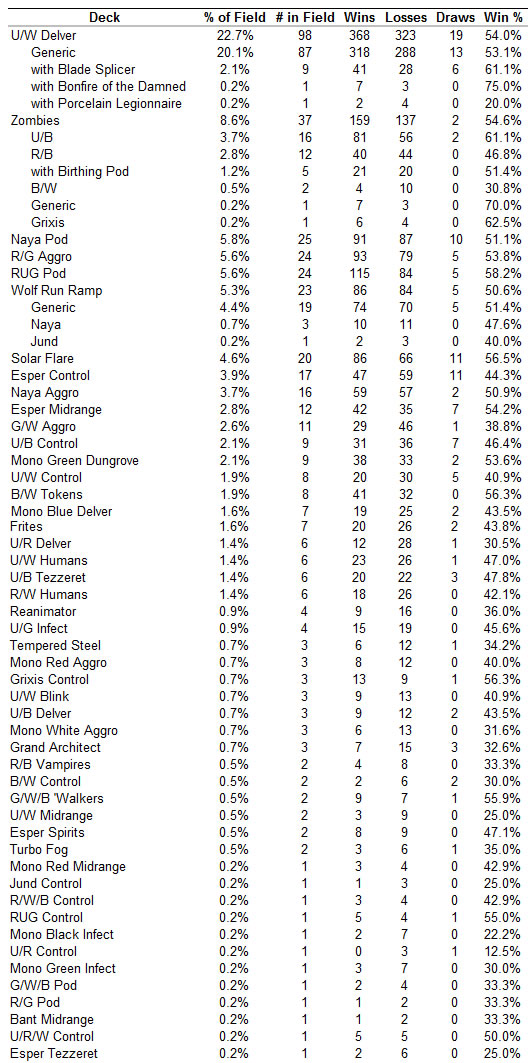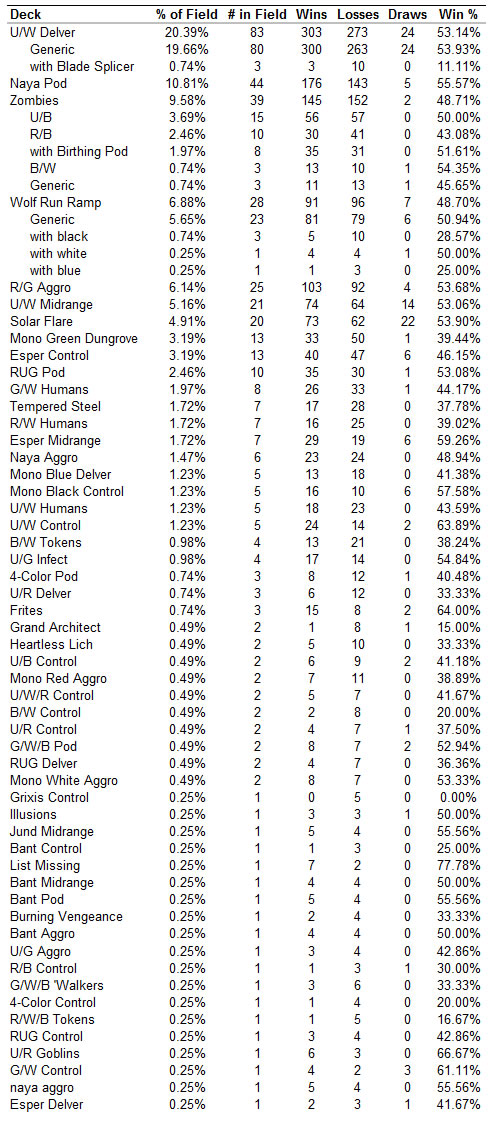Before I get into it, I want to briefly mention one thing. There’s a lot of information in these articles, but you don’t have to ingest all of it. There are different pieces of information that are relevant to different readers, so feel free to skim for what’s important to you.
In my previous installment, I discovered that Delver didn’t have as much of a stranglehold on the format as expected. It still proved to be a very strong deck, but there were other decks (primarily Naya Pod and Wolf Run Ramp) whose results rivaled Delver’s. Delver is obviously not about to lose its grasp on being the most played deck, but as the number one target maybe it will see a drop in its win rate. With SCG Standard Opens in Detroit and Seattle in the books, we’ll see if the players have come to a similar conclusion and if the results are any different.
Detroit Standard Open
U/W Delver remained most played deck by close to three times the next most played deck. Much like before, its win percentage (54%) was high, but not high enough to justify that kind of field percentage dominance.
Solar Flare dropped from the second most played deck to the seventh, with RUG Pod taking its place among the Top 6. The rest of the Top 6 decks remained the same.
Zombies variants remained near the top of the most played decks and managed a win percentage rivaling that of U/W Delver. The twelve players that played B/R versions and the two that played B/W versions brought down the group’s overall win percentage, but the B/U version (also the most played version) had a 61.1% win percentage.
The rest of the Top 6 decks each took up about the same amount of the field at 5.6%. In order of performance they were: RUG Pod, G/R Aggro, Naya Pod, and Wolf Run Ramp.
RUG Pod has slowly gone from being an unknown entity to one of the most played decks (if only in this event). It also had the highest win percentage of significantly played decks at 58.2%.
Of the remaining three top decks, the biggest drop in win percentage came from Wolf Run Ramp at 5.2%, which is surprising because it was one of the decks that showed the most potential at the end of the last installment. The rest of the stats for the top decks remained largely the same as previously.
Despite being 22.7% of the field, only one Delver deck cracked the Top 8 of the event. In fact, only two decks were the same, with the other six being unique.
Seattle Standard Open
SCG Open Series: Seattle featured a few noticeable differences from Detroit.
U/W Delver this time was only twice as popular as the next most played deck, and its win percentage dropped only slightly.
Naya Pod nearly doubled in popularity and still managed to increase its win percentage to 55.6%.
Despite Naya Pod taking Zombies place as number two, its numbers actually increased a bit, but this time its win percentages suffered. Only the B/W and Pod versions did better than 50%, and not by much.
U/W Midrange made its first appearance in the Top 6 decks after being nonexistent in previous events most likely due to it winning the Magic Online Championship the week before Seattle. Its win percentage was 53.1%.
RUG Pod dropped to only 2.5% of the field and down to a win percentage of 53.1%.
Once again, the Top 8 only featured one Delver deck and had six unique decks, which is a really good indication of the format’s diversity.
Top Deck Stats
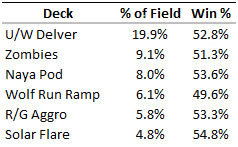
Despite a few shifts in the two individual events, the most played decks remained the same as last time but with a few seed changes. Most notably, Naya Pod moved up from sixth to third and Solar Flare dropped down from second to sixth.
Zombies and Solar Flare both surpassed their prior sub-50% win rates, while Wolf Run Ramp took a dive to be the only one of the top played decks with a sub-50% win rate despite previously showing promise.
Naya Pod, G/R Aggro, and Solar Flare all ended with higher win percentages than U/W Delver.
UW Delver Matchups
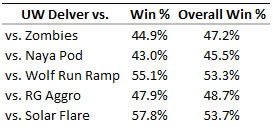
Delver shows the same strengths and weaknesses as last time, but this time they are more exaggerated. Its good matchups improved a bit, and its bad matchups got a bit worse except in the case of G/R Aggro, which dropped below the crucial 50% mark. Now, three of the top played decks have proven to be bad matchups. Delver is still proving to be a force, but once again, its numbers don’t justify it being played twice as much as the next most played deck.
Zombies Matchups
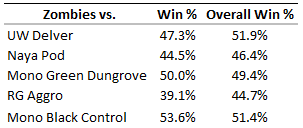
This chart was so surprising to me that I actually had to triple check that it was right. After increasing in popularity, not only did four of Zombies matchups improve from last time, but they improved dramatically in every case. I think the most likely explanation for this is the simplest one: a lot of players didn’t come prepared to beat Zombies.
If you look at Zombies overall win percentages, you’ll see that even with these increases the deck looks pretty bad.
Naya Pod Matchups
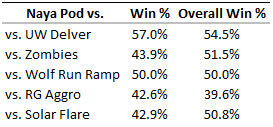
Naya Pod was one of the decks that showed promise last time, but it didn’t meet expectations this time around. Two of the matchups that were over 50% (Zombies and Solar Flare) dropped dramatically.
I’m not sure what happened to the Zombies matchup in which I assume Naya Pod has a big edge (Blade Splicer and Huntmaster being huge there), but I know that Naya Pod is incredibly weak to Day of Judgment, which is a card that some Solar Flare players might have started packing.
The deck’s overall win percentages are still reasonable. The only deck that has given it problems throughout events is G/R Aggro (Bonfire you).
Wolf Run Ramp Matchups
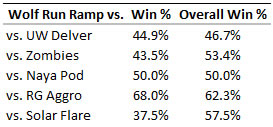
The other deck that showed promise also didn’t perform well. Its overall win percentages still look really good, but Wolf Run Ramp had a pretty bad pair of events. In a similar fashion to Naya Pod, Wolf Run Ramp lost its edges against Zombies and Solar Flare by a serious margin. Maybe it’s not such a good choice after all.
G/R Aggro Matchups
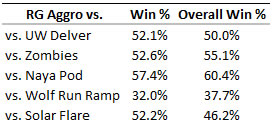
G/R Aggro performed very well this time, with its only sub-50% matchup being Wolf Run Ramp. The matchup is so bad because G/R Aggro has a lot of cards that do nothing against a ramp deck and its creatures (save Wolfir Silverheart) also happen to be weak to Whipflare and Slagstorm.
My proposed solution to the matchup is Hellrider in the board (in addition to Zealous Conscripts), as long as you can cast it. It also helps against Solar Flare, which is the next most difficult matchup.
With good/even overall win percentages against the Top 3 decks, G/R Aggro continues to be a strong deck choice.
Solar Flare Matchups
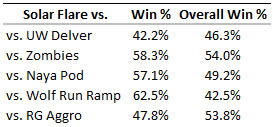
After so many players dropped Solar Flare for these events, its win rates started to go up. The only matchup that went down was U/W Delver. Its overall win percentages still don’t make the deck look very appealing, but the remaining Solar Flare players seem to be doing something right (playing Day of Judgment maybe).
Wrap Up
It’s always possible we could see a shift in the format from week to week, but even with M13 around the corner I don’t think we’ll see many changes in coming weeks. U/W Delver has been considered the best deck for long enough that most players who play it won’t see any reason to change. Though, seeing that its numbers aren’t actually that good, it might not pick up any new players either.
Naya Pod and Wolf Run Ramp showed promise last time but didn’t do nearly as well this week. The best performing deck this week was G/R Aggro, which is in good position in the format with its only notable bad matchup being only 6.1% of the field.
Maybe M13 will shake things up in coming weeks. It probably won’t, but it sure would be nice (I may or may not be the guy who wants to see Battle of Wits).
Thanks for reading!
Find me on Twitter @theshipitholla
Watch my Livestream http://www.twitch.tv/theshipitholla

